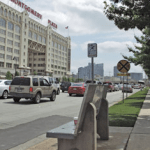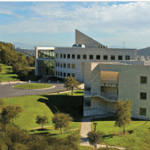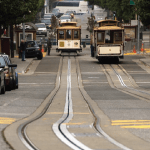Top Story
Because transportation investments are so inextricably linked with urban form, because they matter greatly for real estate decision making, and because they are so vital to national and metropolitan prosperity, for the past five years ULI has made it a priority to engage in national conversations about the future of surface transportation policy. This work has been generously supported by the Rockefeller Foundation and other partners.
2011 Archive
Federal Transportation Bill Forecast: Continued Uncertainty by Rachel MacCleery, November 2011. “Transportation experts gathered at ULI’s 2011 Fall Meeting in Los Angeles in late October looked into the country’s transportation future and predicted continued uncertainty at the federal level, along with a need for increased innovation at the state level, and increased private sector involvement in transportation infrastructure provision at the local level.”
Federal Transportation Policy in Motion? by Sarah Jo Peterson, July 2011. “The current extension of the federal transportation authorization expires on September 30—meaning that the House Republicans and the Senate have limited time to bridge the gaps in their positions.”
In Dallas, A Downsized Transportation Plan by Rachel MacCleery, July 2011. “The Dallas–Fort Worth area and north Texas, faced with a shrinking transportation budget and a growing population, are planning for a denser, more compact future.”
Federal Transportation Bill Uncertain; Cities Find New Ways to Finance Streetcars by Rachel MacCleery, June 2011. “Prospects for federal transportation reauthorization are dim for a variety of reasons, including the sense among many members of Congress that the transportation program is no longer serving a national purpose.”
Role of Private Sector Shifting in Transit Partnerships by Rachel MacCleery, June 2011. “In Dallas and Los Angeles, local leaders are forging new partnerships and collaboration strategies in order to move forward with streetcar investments. Diminishing public revenues will mean that in these cities and elsewhere, private entities—including real estate developers—will be taking on new roles as transit funders, builders, and operators.”
2010 Archive
Lessons from California for a New National Bank for Infrastructure by Rachel MacCleery, November 2010. “As the Obama administration and Congress begin to flesh out how a new national infrastructure bank will function, the California I-Bank’s strong track record and focus on infrastructure make it worth a close look.”
The Transportation Calculus (PDF) by Rachel MacCleery, July/August 2010. “Homebuyers and renters these days have a lot of information at their fingertips. Now, transportation cost data are starting to show up alongside traditional house facts and figures. Rachel MacCleery explores what the new availability of transportation cost information will mean for real estate”
Coalition Pushes for New Ways to Fund U.S. Infrastructure (PDF) by Maureen McAvey, January/February, 2010. A news conference by Building America’s Future voiced support for greater investment in infrastructure and urged President Obama and members of Congress to make creation of a national infrastructure bank a top domestic priority for 2010.
2009 Archive
ULI Releases Recommendations for Transportation Reform (PDF) by Rachel MacCleery, August, 2009. Heralding the release of Transportation for a New Era, MacCleery calls for significant reform in transportation policy.
Transportation Reform in the Limelight (PDF) by Rachel MacCleery, July, 2009. MacCleery provides an overview of differing approaches proposed by House leadership and the Obama administration on how to proceed with legislation and funding for transportation reform.
A National Infrastructure Bank for the U.S.? (PDF) by Rachel MacCleery, July, 2009. Rachel MacCleery analyzes the potential for an infrastructure bank in the U.S., referring to existing examples and outlining next steps.
Creating a Framework for a Greener Economy (PDF) by David Burwell, May 2009. David Burwell discusses responsible development strategies as a feature in Urban Land Green.
Transportation Solutions (PDF) by Arlee Reno et al, May, 2009. Reno reports in Urban Land Green on research that proves “very significant reductions in greenhouse gases can be achieved through mobility-related measures that also save money and support strong economic growth.”
U.S. Infrastructure Spending: How Much Is Enough? (PDF) by Sarah Jo Peterson, April, 2009. Sarah Jo Peterson looks at what engineers, economists and environmental innovators have to say about how much infrastructure spending is “enough.”
Dialogue: Reform, Transportation Reauthorization Options (PDF) by Jeffrey Spivak, April, 2009. Jeffrey Spivak reviews the transportation reform positions of a variety transportation associations and interest groups, finding that they have a lot– but not everything– in common.
Dialogue: Transportation, An Interview with Judith Rodin (PDF) by Rachel MacCleery, April, 2009. Rachel MacCleery interviews the president of the Rockefeller Foundation, Judith Rodin, who discusses why transportation reform is critical for American prosperity and sustainability.
The Transportation Opportunity (PDF) by Tom Murphy and Rachel MacCleery, January, 2009. An article in the January 2009 edition of Urban Land discusses America’s transportation policy, saying it should further the goal of energy independence.


